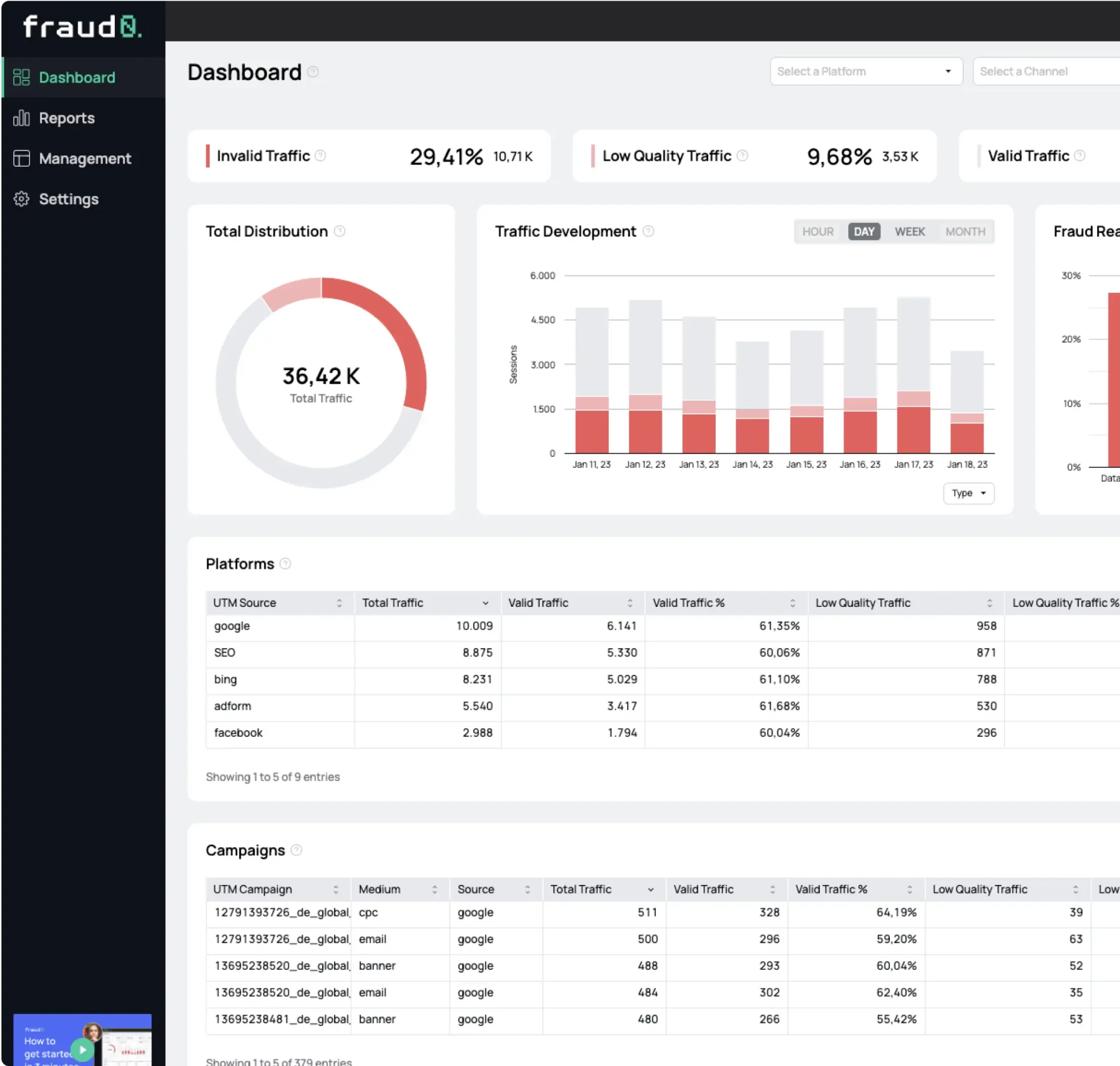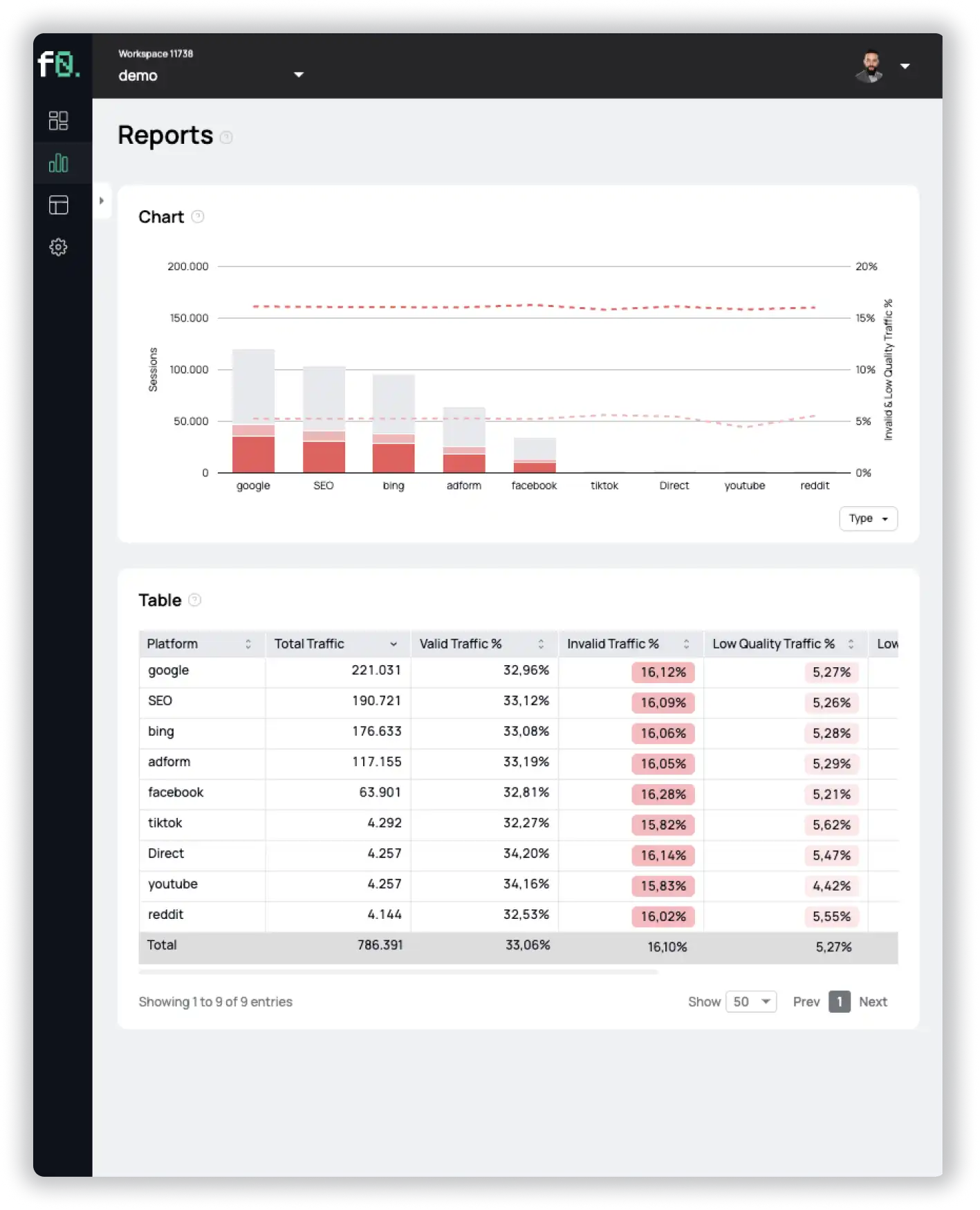- Blog
What is a Click Farm and how to protect your ad budget from it?

Oliver Kampmeier
Cybersecurity Content Specialist

What is a click farm?
A click farm is a professionally organized group of workers (called “click workers”) whose job is to click on ads on the Internet, share social media posts, or post comments.
They operate mostly from developing countries and in a legal gray area, although they are clearly involved in advertising and click fraud.
What dimensions this “business sector” can take (and what consequences threaten workers) is impressively shown in this short documentary:
Why do click farms exist?
This question is pretty easy to answer: click farms exist to introduce human behavior into the click / ad fraud process. Most bots are very quickly recognized as such by their rigid behavioral patterns. Click workers are supposed to be perceived as real users on the respective websites due to their human and natural mouse movements and click intervals.
What are click farms used for?
There are many possible uses for a click farm. The following, among others, come into consideration.
Fraud with clicks on advertisements of own fake websites
Click farms often maintain a large network of their own websites. These usually look like a copy of existing offers in order to give a positive impression at first glance. The websites are created automatically with the help of bots, filled with stolen content and then registered for marketing in various advertising networks.
Click farm workers are then encouraged to visit these websites and click on the ads there. Since PPC (Pay-Per-Click) methods are often used, the Click Farm operators earn money on every ad clicked. How high this profit is depends on numerous characteristics of the placed advertisement – but it is definitely higher than the wage costs for the hired click workers.
With this method, click farms are responsible for a significant part of click fraud.
Increasing the reach of other companies
Increasing your own reach on the Internet is costly and complex – especially in industries with high competitive pressure. Plenty of time passes before a certain visibility is achieved and a lot of marketing budget has to be invested. Often, Likes, Shares, Retweets, Comments and similar indicators are used to see whether one’s business is increasing in terms of awareness and reach.
A Click Farm can drastically shorten this path, as Likes & Co. can be easily bought. For $10, for example, you can get 1,000 likes from a click farm in Bangladesh – much cheaper than a “real” advertising campaign with the same result. So, some companies deliberately use click farms as a cheaper substitute for advertising measures.
Such a high level of interaction in a short time can also additionally lead to increasing the virality of a post. Most platforms use algorithms that present particularly popular and highly interactive posts to their users more prominently in their feed – regardless of whether this prominence came about through interactions of real users or through a click farm.
In times when hype and virality is often the most important tool of all to differentiate oneself from the competition, this creates tempting incentives for companies to engage with a click farm.
Contract work – clicks to harm the competition
Some unscrupulous companies use the service of a click farm not to increase the reach of their own content, but to specifically harm their competition.
The hoped-for competitive advantage of this method opens up in 2 ways:
- The daily budget limit of the competition is exhausted by the click farm already in the first hours of the day, which is why the own ads can be placed more prominently for the rest of the time (e.g. with GoogleAds).
- The competition’s advertising budget is basically siphoned off with every ad click, which causes marketing costs to skyrocket and, if necessary, marketing activity is temporarily paused.

What techniques are used in click farms?
A click farm operates most effectively when it is not recognized as such or when blocking is made impossible. To achieve this, several methods are conceivable:
- Click workers use real devices with real SIM cards registered to real people. These can be, for example, hundreds or thousands of smartphones set up side by side in a click farm so that workers can operate them all simultaneously.
- If websites or advertising partners detect suspicious behavior, it doesn’t have to be the end of the world. The device IDs of the devices used are regularly reset so that access to the websites or advertising is possible again.
- VPNs and proxy servers are excellent for disguising the real position. This is often done in order to display advertisements from (western) countries with higher purchasing power, as these bring more money per click. Thus, the Click Farm workers may be sitting in Indonesia, while the ad network, however, believes that it is a person from the USA.
The operators of the click farm know very well that they are legally operating in a questionable gray area. Through various concealment measures, they ensure that at least their location cannot be identified so easily.
Where are click farms located?
The payment for working in a click farm is extremely poor (more on this later). This means that, from the start, only countries where even this miserable payment is still incentive enough to pursue this activity are considered for the operation of such a farm. Therefore, developing countries are often used. Popular locations can be found in many countries in Southeast Asia, such as Thailand, India, Bangladesh and Pakistan.
The location only needs to have a stable Internet connection with sufficient bandwidth for the click farm to pursue its activity. Urban areas such as major cities in India or in some countries in South America are therefore ideally suited: They offer the necessary infrastructure and at the same time are “poor enough” to ensure the operation of the farm for little money.
However, there have also been indications in the past of click farms operating out of Africa or Eastern Europe.
Are Click Farms illegal?
Obviously, a click farm is a form of advertising fraud. Fake websites are used to cheat companies out of their advertising budget. The ads are clicked by real people, unlike botnets, but no click worker intends to convert. The damage to advertisers is considerable.
However, the legal situation is not always quite so clear and is therefore more comparable to a gray area. The fraud usually takes place transnationally, which makes prosecution much more difficult. In addition, many developing countries do not yet have laws prohibiting the operation of a click farm.
Most police operations related to click farms are not related to their operations and business model, but to the working conditions and permits of the click workers on site.
Poor working conditions for click workers
For several reasons, working in a Click Farm is miserable:
- The pay is disastrously poor. On average, click workers earn $1 for every 1,000 clicks performed. If we hypothetically assume that a worker performs one click every two seconds, this would be an hourly wage of 1.80 US dollars – completely without breaks or slackening of concentration. That such a work rate is even achievable due to website loading times and human “breathers” is probably questionable.
- A click farm runs around the clock, usually with individual employees working eight to ten hour shifts. Breaks or distractions are not allowed, listening to music during the very monotonous and repetitive “work” is prohibited. This results in a high attrition rate of employees who need to be constantly replaced.
However, click workers are sometimes persuaded to cooperate with a few tricks. They are pompously called “head of marketing” or “IT specialists,” although they take on a task for which no qualification is necessary. As a result, the workers there are not always aware that they are operating in a legal gray area. Deliberately grandiloquent names of such a click farm further help to underscore the image of an important advertising agency.
How do Click Farms make money?
Click Farm’s operating profit is realized mainly through two income streams:
- They work on their own, creating fake websites themselves and finally using Click Workers to earn money through clicks on the embedded ads. The delta between the expenses for the workers and the income from the advertising is the Click Farm’s revenue. The more workers they employ, the higher usually the revenue. That is why it is an advantage for a click farm to push the expenses for workers as much as possible.
- Click farms work for companies or sometimes individuals who want to buy more reach. These contact a click farm and buy, for example, 1,000 clicks or 500 retweets for $10. However, since 1,000 clicks only cost the click farm an average salary of one US dollar, the profit margin is considerable. The profit flows into the pockets of the click farm operators, who mostly exploit emergency situations (young, poor people) of the workers.
Due to the regions in which the click farms operate and their legal status, it is also doubtful whether the profit generated is taxed – which further increases the profit margin for the operators.

See what’s hidden: from the quality of website traffic to the reality of ad placements. Insights drawn from billions of data points across our customer base in 2024.
How much do click farms cost?
The offer of click farms is extremely cheap. The aforementioned offer of $10 for 1,000 clicks is not an exception, but the norm. With these absolute dumping prices, it is not surprising that this form of reach increase on the Internet is practically always cheaper than placing ads on Instagram, Twitter & Co.
Many click farms also offer calculation examples to substantiate with how little monetary effort the increase in reach is possible. This leads many website operators into temptation. If they can increase the number of likes tenfold with an expense of perhaps $50 a month, this is a clear statement from a business perspective.
How to detect click farms and protect the advertising budget from them?
The problem with click farms is that they are operated by real people. Software and bots are usually easy to distinguish from real visitors based on certain behavioral patterns, thus locking them out of websites. They do not prove any variation in their behavior, which is why the difference with human users is striking. This makes it much easier for websites to detect and stop fraud attempts by most bots.
A click farm, on the other hand, is operated by humans on real existing devices that behave in a correspondingly human manner. Recurring patterns are difficult to detect – especially in a manual way. This may work for a while, but inevitably problems arise:
- Manual detection of fraud attempts is only ever reactive. A website operator determines through an analysis of web traffic that certain accesses are obviously not human in nature – so he blocks them out, for example by blocking IP addresses. However, by using VPNs, click workers bypass any blocking.
- In addition, real users can be blocked out who use the same IP range and therefore also no longer get access to the website’s offer. Thus, the fraud attempts are stopped, but at the same time traffic is lost by potential clients and customers.
Furthermore, such an analysis in a manual way is costly. In addition to the IP addresses mentioned, data that must be used for a comparison may include browser types and versions, the connected network speed, notebook/PC/telephone models, MAC addresses and much more. Website operators therefore have to invest considerable effort, while the benefits are manageable in the end. In the long run, manual detection and blocking of click farms is not an option.
Companies can partially protect their advertising budget from click farms by:
- Setting geotargeting for their campaigns
- Only running ads on websites that are held in an “Allowlist” and have been manually vetted
- Only working with reputable ad networks where the publisher acceptance process is manually audited
- Implement software to automatically detect bots and low-quality traffic, such as from a click farm.

Block click farms automatically
To reliably protect yourself as an advertiser against click farms, the analysis and, if necessary, blocking of website visitors must take place in real time. Fraud prevention software such as fraud0 can provide support here.
After the script has been implemented on your own website, the software analyzes each user 24/7 based on numerous factors such as
- Various device and browser factors
- The behavioral pattern of each user compared to the entire website
By correlating all the data, fraud0 can detect in real time whether traffic is genuine or coming from a bot or click farm. If outliers are detected, the software blocks the corresponding users and also removes them from all retargeting lists so that no further advertising budget is wasted.
This works for all popular advertising channels such as GoogleAds, Facebook, Instagram, or TikTok. If you want to make sure that traffic is organic and therefore has real meaning for your business, fraud0 is the right partner to verify the integrity of traffic and protect your advertising budget.
The growth of Click Farms is unstoppable.
Effective marketing can help set you apart from the competition. Today, the importance of social media and the performance indicators they contain – i.e. likes, shares, etc. – continues to grow.
In order to increase your own reach and thus feed the algorithms of these platforms with high-reach posts, user interactions are necessary. Click farms are therefore currently in the golden age: they offer companies what they need today to gain a competitive advantage.
In the long term, this ensures the destruction of marketing and advertising as an efficient means of promoting and publicizing products and services. A new product launch has 15,000 likes? Nice – but how many of those are real?
The click farm undermines trust in the advertising industry, as it is very difficult to prove how “real” traffic really is. Therefore, the click farm as such is a big problem for the advertising industry.
At the same time, the pressure on companies to make use of these farms is increasing. Advertisers love increasing reach and higher user interactions. If the numbers drop, partners may leave. Spending a few euros to comply with contractual terms is therefore tempting.
Software like fraud0 can help prevent the rise of the click farm. Fake traffic is quickly identified and long-term economic damage is avoided.
Test our software 7 days for free and see for yourself!
- Published: November 3, 2022
- Updated: July 2, 2025
1%, 4%, 36%?




